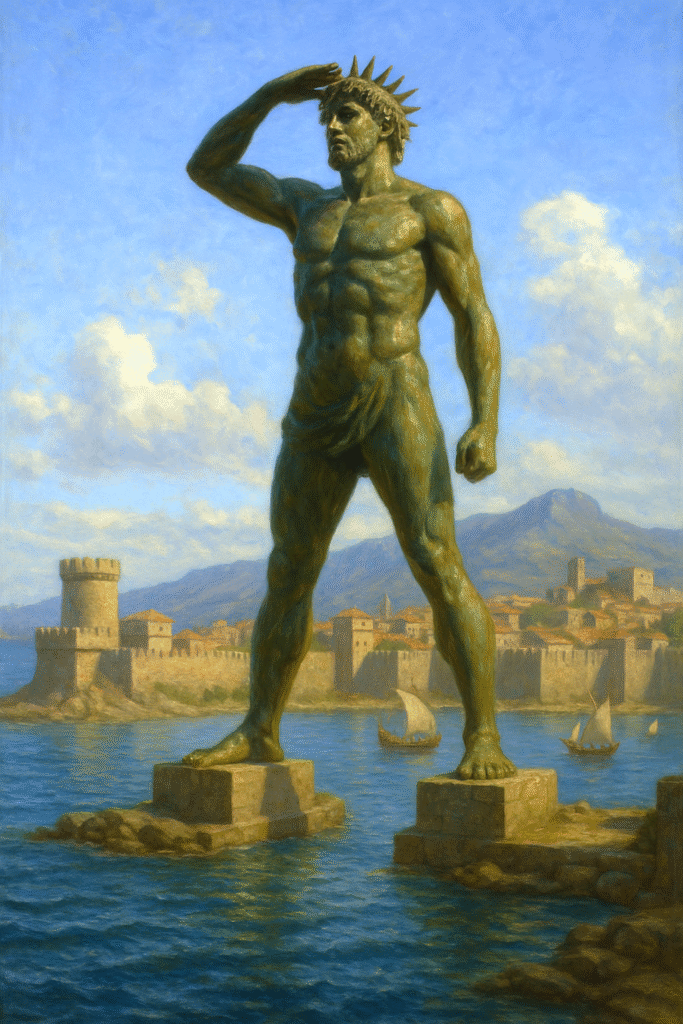Introduction to the Colossus of Rhodes
Standing tall at the entrance of the ancient harbor of Rhodes, the Colossus of Rhodes was a monumental statue that epitomized Greek ingenuity and spirit. Completed in 280 BCE, this colossal figure of the sun god Helios was designed to celebrate the island’s victory over Cyprus and to act as both a landmark and a symbol of unity for the people of Rhodes. As one of the Seven Wonders of the Ancient World, the Colossus not only showcased exceptional artistry and engineering but also became a source of inspiration for countless generations.
The statue stood approximately 33 meters high, making it one of the tallest statues of the ancient world. It was made from bronze plates over an iron framework, and though no descriptions exist from contemporaneous sources, ancient texts suggest that the statue was breathtaking in its scale and craftsmanship. This article explores the historical significance and cultural context of the Colossus of Rhodes, investigates the factors behind its disappearance, and reflects on its cultural legacy in the modern world.
Historical Background and Construction
Origins and Design
The construction of the Colossus was the brainchild of Chares of Lindos, a renowned Greek sculptor. According to ancient sources, including the writings of Pliny the Elder, the statue took a little over 12 years to complete and was funded using the money from the sale of weapons left behind by the invading army of Demetrius I of Macedon. The Colossus was a celebration of not just military victory, but also of artistic achievement, a testament to the skills of Hellenistic craftsmen.
Architectural Features
The statue’s design combined various architectural elements from the classical world. It was constructed using a method of hollow casting, a revolutionary technique that allowed for greater detailing and less material usage. Ruins of the statue in the modern day suggest it might have reflected a delicate balance of human form and grandeur. The bronze surfaces were likely polished to catch the sunlight, casting dazzling reflections across the harbor, making it a beacon to sailors approaching the island.
Historical Context of the Era
The Colossus was built during a time of relative peace and prosperity in Rhodes. The island was a hub of commerce, thanks to its strategic location in the Mediterranean. The Hellenistic period was characterized by a flourishing of arts and culture, with numerous individuals striving to achieve greatness in various fields. The Colossus represented a convergence of political power, technological innovation, and artistic ambition, embodying the ideals of the era in which it was built.
Factors Leading to Its Disappearance
Natural Disasters
Despite its grandeur, the Colossus’s existence was short-lived. Only 56 years after its completion, the statue was severely damaged by an earthquake around 226 BCE. This earthquake, which struck the island with catastrophic consequences, caused the statue to topple over, breaking it into several pieces that scattered on the ground. Contemporary accounts suggest that the island’s inhabitants were unable or unwilling to rebuild the mighty statue, fearing additional natural disasters.
War and Economic Decline
In the wake of the destruction of the statue, Rhodes faced several issues, including – and not limited to – political instability, economic decline, and external pressures. The strategic importance of Rhodes meant that it would continue to be a target for invaders. Following the fall of the Colossus, the city was unable to secure sufficient resources to undertake restoration projects. In republican Rome, Rhodes gradually lost its significance as a major trade hub, further stifling any potential revival of interest in restoring the statue.
Cultural Shift
By the time of the Romans, there was a shift in cultural priorities. The focus turned towards new models of power such as monumental arches and amphitheaters, often in cities that displayed Roman technological advancement. In this context, the Colossus of Rhodes became a relic of the past rather than a priority for revival. The remnants of the statue lay undiscovered for centuries, eventually leading to its complete disappearance into history’s obscurity.
Cultural Legacy and Modern-Day Relevance
A Symbol of Ingenuity and Inspiration
The Colossus of Rhodes continues to inspire generations, serving as a symbol of innovation and aspiration. Its conception reflects human creativity directed towards achieving the seemingly impossible, reminding us of the heights that can be reached through collaboration and ingenuity. Artists, architects, and historians frequently draw upon the lessons embodied by the Colossus, considering it an exemplar of the human spirit’s resilience and creativity.
Modern Interpretations
In contemporary contexts, the spirit of the Colossus has been revived in various forms of art and architecture. Notable examples include New York’s Statue of Liberty and Rio de Janeiro’s Christ the Redeemer, both of which pay homage to ideas of welcome and unity, much like the original statue. Additionally, the Colossus has found its way into literature and popular culture, inspiring numerous works of fiction that explore themes of awe, grandeur, and loss.
Philosophical Reflections
The disappearance of the Colossus offers profound philosophical reflections on knowledge and wonder. The statue stood as a testament to mankind’s capacity for greatness, yet its eventual demise reminds us of the impermanence of human achievement. In this light, the Colossus can be viewed as a metaphor for the fragility of human success—how the greatest creations can sometimes be rendered insignificant or forgotten by the forces of nature or changing societal values.
Conclusion and Personal Reflections
The Colossus of Rhodes, though lost to history, remains a lasting symbol of creativity, ambition, and the human endeavor for greatness. Our fascination with such ancient wonders invites us to reflect on our own contributions to culture and civilization. It challenges us to continue pushing boundaries, understanding that even the most monumental achievements can face the test of time. As history enthusiasts, travelers, and seekers of cultural knowledge, we are encouraged to appreciate the lessons of the past, carry forward their essence, and create legacies that inspire future generations.
From its breathtaking construction to its eventual downfall, the story of the Colossus of Rhodes exemplifies the eternal blend of human artistry and the impermanence of existence. Acts of creation, much like the Colossus itself, hold both awe and fragility, reminding us that while we may leave our mark on the world, we must also remain humble in understanding that time alters everything.
FAQ Section
What was the Colossus of Rhodes made of?
The Colossus of Rhodes was primarily constructed from bronze plates that were affixed to a stone and iron framework. This innovative construction technique allowed for a tall, stable structure that could still showcase exquisite detail.
How tall was the Colossus of Rhodes?
The statue stood around 33 meters (108 feet) tall, making it one of the tallest statues of the ancient world, rivaled only by the Statue of Zeus at Olympia.
When was the Colossus of Rhodes destroyed?
The Colossus of Rhodes was destroyed by an earthquake in 226 BCE, just 56 years after its completion.
Why was the Colossus not rebuilt after its destruction?
Due to subsequent wars, economic decline, and a fear of future disasters, the inhabitants of Rhodes chose not to rebuild the statue.
What does the Colossus of Rhodes symbolize today?
Today, the Colossus of Rhodes symbolizes human creativity and ambition. It serves as a reminder of both the capabilities and fragility of human achievements.
Are there any surviving remnants of the Colossus of Rhodes?
No remnants of the Colossus of Rhodes exist today; after its destruction, the statue lay in ruins, and its remnants were ultimately lost to time and the elements.


